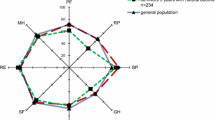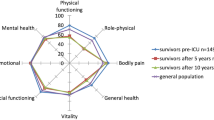Abstract
Performance of intensive care is usually quantified by means of standardized mortality rates, where standardization is directed towards the severity of illness on admission. However, as more critically ill patients survive, functional outcome and quality of life of these patients becomes more important. In a prospective study in a 10-bed tertiary paediatric intensive care unit (ICU), admission and follow-up health status were collected for 209 surviving patients. For this cohort of patients, health status 1 year after admission was also predicted, using the quantified health-utility-index (HUI), as a value between 0 and 1. For this purpose, two alternative multiple regression models were constructed. The most important predictors of 1-year health status were the level of sensation, mobility and cognition on admission to which self-care, systolic blood pressure, oxygen, Glascow Coma Scale, glucose and age may be added. The two alternative predictive models performed equally well (R2=0.83 and 0.84 respectively), indicating that health status could be predicted to a significant degree. The concept of relating expected future health status (based on base-line health status), with actual (observed) health status is denoted with the Standardized Health Ratio (SHR). In combination with the Standardized Mortality Ratios (SMR), such a ratio may become a new comprehensive indicator of performance in intensive care medicine.
Similar content being viewed by others
References
Knaus WA, Draper EA, Wagner DP, et al. An evaluation of outcome from intensive care in major medical centers. Ann Intern Med 1986; 104: 410-418.
Knaus WA, Draper EA, Wagner DP, Zimmerman JE. APACHE II: a severity of disease classification system. Crit Care Med 1985; 13: 818-829.
Lemeshow S, Teres D, Klar J, Avrunin JS, Gehlbach SH, Rapoport J. Mortality Probability Models (MPMII) Based on an InternationalCohort of IntensiveCare Unit Patients. JAMA 1993; 270: 2478-2486.
LeGall J, Lemeshow S, Saulnier F. A New simplified Acute Physiology Score (SAPSII) Based on a European/North American Multicenter Study. JAMA 1993; 270: 2957-2963.
Pollack MM, Ruttimann UE, Getson PR. Pediatric Risk of Mortality (PRISM) score. Crit Care Med 1988; 16: 1110-1116.
Knaus WA, Draper EA, Wagner DP, Zimmerman JE. An evaluation of outcome from intensive care in major medical centers. Ann Int Med 1986; 104: 410-418.
Wu AW, Damiano AM, Lynn J, et al. Predicting future status for seriously ill hospitalized adults. Ann Intern Med 1995; 122: 342-350.
Barr RD, Pai MKR, Weitzman S, et al. A Multi-attribute approach to health status measurement and clinical management - illustrated by an application to brain tumors in childhood. Intern J Oncol 1994; 4: 639-648.
Feeny D, Furlong W, Barr RD, Torrance GW, Rosenbaum P, Weitzman S. A comprehensive multi-attribute system for classifying the health status of survivors of childhood cancer. J Clin Oncol 1992; 10: 923-928.
Gemke RJBJ, Bonsel GJ, van Vught AJ. Long term survival and health status after paediatric intensive care. Arch Dis Childh.1995; 73: 196-201.
Gemke RJBJ, Bonsel GJ. Reliability and validity of a comprehensive health status measure in a heterogeneous population of children admitted to intensive care. J Clin Epidem 1996; 49: 327-333.
Torrance GW, Furlong W, Feeny D, Boyle M. Multi-attribute preference functions. Health Utility Index. Pharmacoeconomics. 1995; 7: 503-520.
Abdalla M, Russell I. Tariffs for the EuroQol health states based on the modelling of the individual VAS and TTO data of the York survey 1993. In: O'Hanlon M, Buxton M, eds. EuroQol Conference Proceedings 1994. HERG Research Report no. 20. London: Brunel University, 1995: 75-92.
Konopad E, Noseworthy TW, Johnston R, Shustack A, Grace M. Quality of life measures before and one year after admission to an intensive care unit. Crit Care Med 1995; 23: 1653-1659.
Hulsebos RG, Beltman FW, Reis Miranda D, Spangenberg JFA. Measuring Quality of Life with the Sickness Impact Profile: a pilot study. Intensive Care Med 1991; 17: 285-288.
McDowell I, Newell C. Measuring health: a guide to rating scale and questionnaires. Oxford, UK: Oxford University Press, 1987.
Madagame ET, Havens PL, Bresnahan JM, Babel KL, Splaingard ML. Survival and functional outcome of children requiring mechanical ventilation during therapy for acute bacterial meningitis. Crit Care Med 1995; 23: 1279-1283.
Author information
Authors and Affiliations
Rights and permissions
About this article
Cite this article
de Keizer, N.F., Bonsel, G.J. & Gemke, R.J.B.J. Health status prediction in critically ill children: A pilot study introducing Standardized Health Ratios. Qual Life Res 6, 192–199 (1997). https://doi.org/10.1023/A:1026450403009
Published:
Issue Date:
DOI: https://doi.org/10.1023/A:1026450403009




